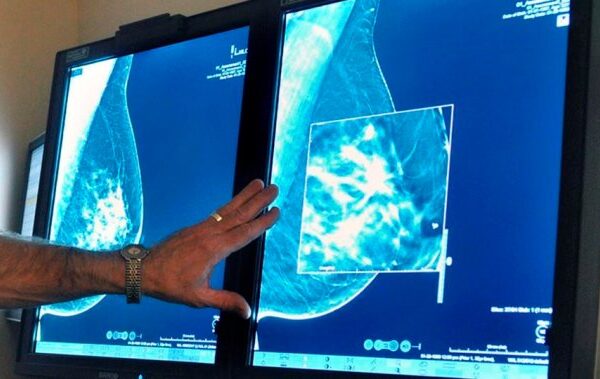
In the United States, breast cancer is on the rise among young women, even as deaths decrease: study – National
The number of deaths breast cancer is declining, but new data from the United States shows that the prevalence of cases among women under 50 is increasing. This has supporters for breast cancer screening once again urging change in Canada. The study, published in CA: A Cancer Journal for Clinicians Tuesday, found that the number of deaths had decreased by 44 percent between 1989 and 2022. “I think it’s amazing,” Kimberly Carson, CEO of Breast Cancer Canada, told Global News. “That’s why we work as hard as we do in research to be able to change these statistics.” There were about 518,000 fewer deaths overall during this period, although some demographic groups did not see the same decline. American Indian and Alaska Native women saw no reduction in mortality, while black women had 38 percent higher mortality than white women, despite having a 5 percent lower incidence rate. Story continues below advertisement In fact, the study notes that this group has the lowest survival rate of all racial and ethnic groups for every breast cancer subtype and disease stage except for “localized stage.” to which they are 10 percent less likely than whites. women to be diagnosed. However, even with these discrepancies, the study indicates that the decrease in overall deaths is largely due to advances in treatments and earlier detection through screening. “The sooner we catch it, the better the outcome,” Carson said. “Screening is obviously a very high priority, because we can catch it at stage 0, stage 1… your chances of surviving breast cancer are almost 100 percent.” Why are cases increasing among young women? According to the study released Tuesday, the incidence of breast cancer increased by one percent each year between 2012 and 2021. Story continues below advertisement The study noted that the increasing trend was mainly limited to hormone receptor-positive diseases, in which breast cancer cells have receptor proteins to which estrogen and progesterone attach, thereby stimulating cancer growth. Receive weekly health news Receive the latest medical news and health information every Sunday. In addition, the study notes that associated risk factors, such as increased excess weight and a continued decline in fertility rates, also contributed – notes the Canadian Cancer Society. not getting pregnant at all increases the risk of breast cancer, while “the more children a woman has, the greater her protection against breast cancer.” Learn more about Canada More videos The data revealed various differences by race and ethnicity, with women of Asian American and Pacific Islander descent experiencing the fastest increase. Those under 50 saw a higher increase of 2.7 percent, compared to 2.5 percent for those 50 and over. Among white women, there was an annual increase of 1.4 percent among those under 50, compared to 0.7 percent among those 50 and older. The increase in cases among younger women is just the latest in a series of studies showing that various types of cancer are on the agenda. increase in young adultswith a study published in The Lancet in July showing higher incidence rates in Generation X and millennials for 17 of 34 types of cancer, including breast, pancreatic and stomach forms. Early detection is a key way to get ahead of the disease or treat it quickly, but that’s proving to be a potential problem north of the border, where data suggests similar trends. Story continues below advertisement A study released in April revealed a similar increase among Canadian womenespecially among those under 50. There was an average of 5.7 cases per 100,000 people in their 20s per year between 2015 and 2019, an increase of 45.5% compared to the number observed between 1984 and 1988. Current trend TD Bank to pay more than $20 million in identity theft charges The strike at American ports will have an “absolutely massive” impact on Canada. Here’s why There was also an increase between these two periods of 12.5 percent for those in their 30s and 9.1 percent for those in their 40s. The Canadian Task Force on Preventive Health Care in May kept its guidelines in placewith regular screening mammograms only recommended for patients aged 50 to 74, although women in their 40s can request them. 1:59 Decision on breast cancer screening triggers review by Canadian task force The task force said its position was due to concerns about overdiagnosis and unnecessary biopsies, but some experts called it “outdated and flawed”, and Health Minister Mark Holland announced. he opened an external review within the working group in the middle of its decision. Story continues below advertisement The working group’s decision came even though The United States lowered its own recommended age to 40, and Ontario said testing would be expanded this fall. Carson said the U.S. study shows the rate among young women is rising and the lack of movement in Canada is “regrettable.” “It saves lives if we catch it earlier and it will cost the system less if we can catch it earlier,” she said. A recent Angus Reid poll from last month, ordered by the organization, found that 94 percent of Canadians thought screening should begin at age 40, but more than 27 percent said neither they nor a loved one had been screened and that, depending on when cancer is detected, treatment changes. “If you’re diagnosed at zero or stage 1, you can just have a lumpectomy and radiation and away you go, as opposed to, say, stage 3, where you might be looking at chemotherapy, surgery, again chemotherapy, radiotherapy; it’s definitely a longer trip,” Carson said. According to the Canadian Cancer Society, there are steps you can take to reduce your risk, such as limiting your alcohol consumption, being physically active and following screening advice. — with files from Katie Dangerfield of Global News © 2024 Global News, a division of Corus Entertainment Inc. Source link





















